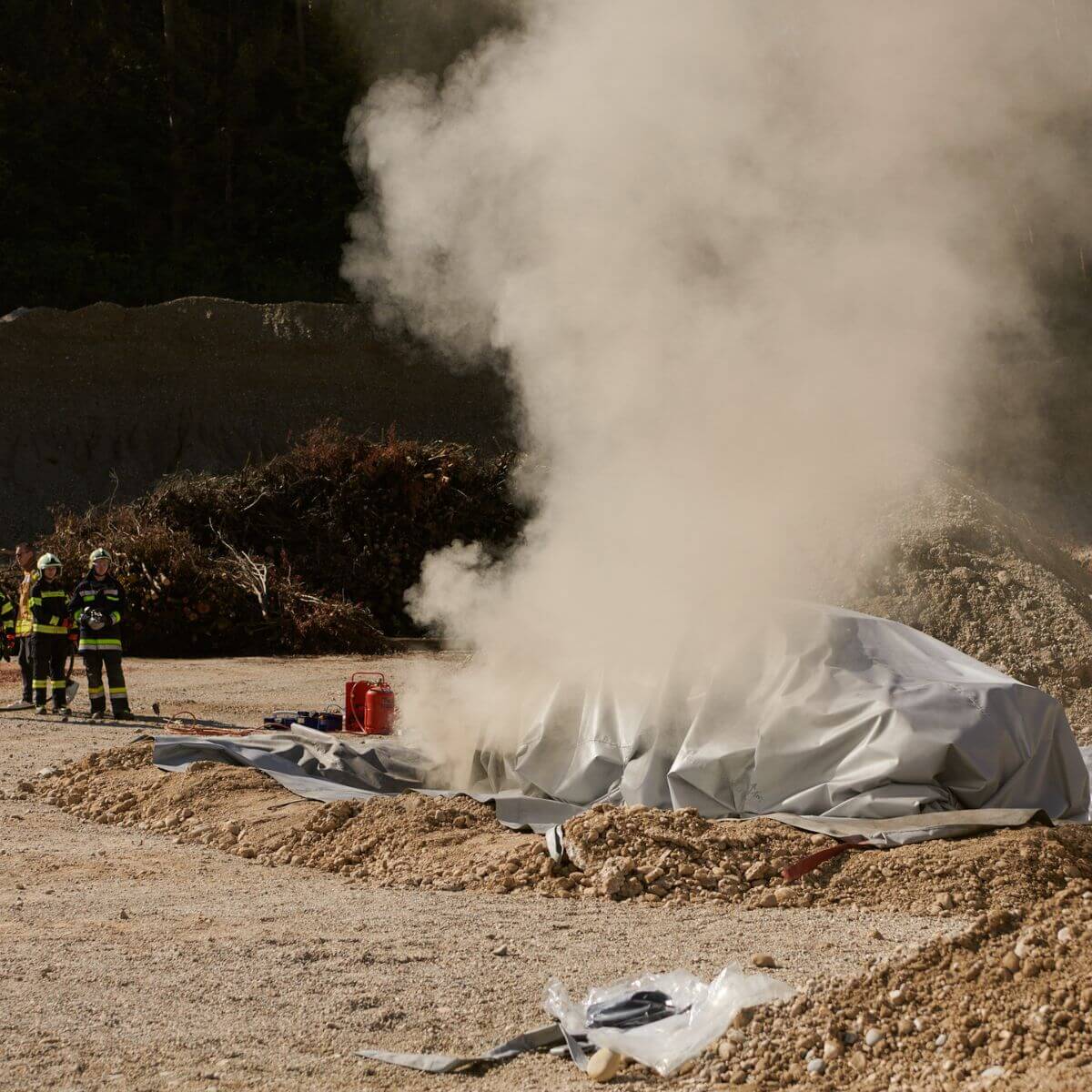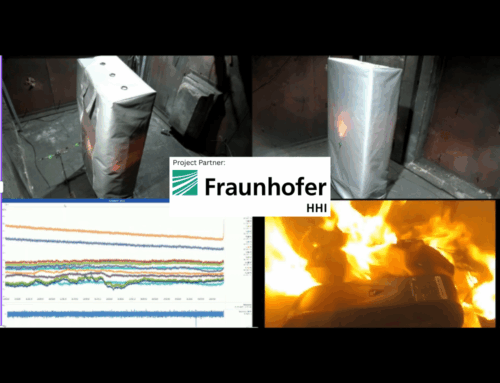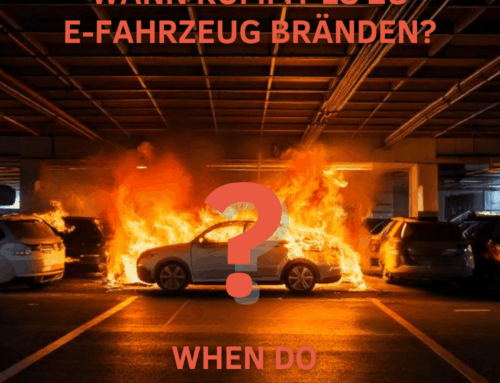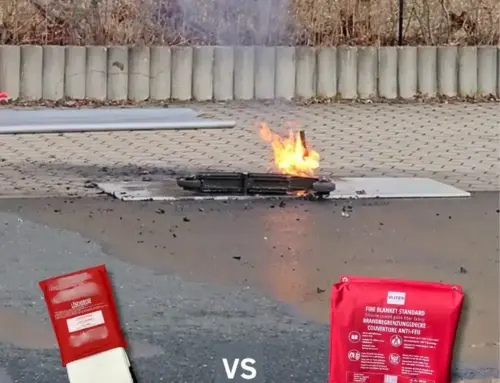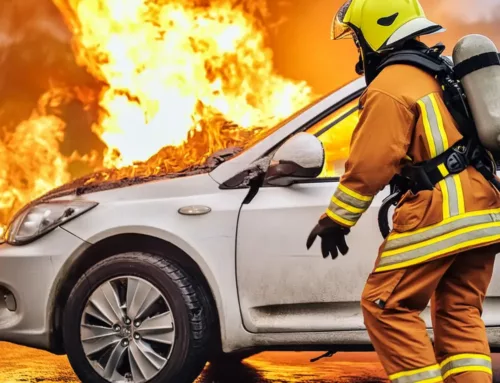
Im September 2021 hatten wir die Gelegenheit, das VLITEX Car Service Set unter realitätsnahen Bedingungen zu testen. Gemeinsam mit dem ADAC und der Feuerwehr Hochburg/Ach simulierten wir einen Akkubrand bei einem verunfallten E-Auto. Ziel war es, die Leistungsfähigkeit unserer Brandbegrenzungsdecke zu demonstrieren und neue Erkenntnisse zu gewinnen, die in die Weiterentwicklung unserer Produkte einfließen können.
Inhaltsverzeichnis
Ziel der Übung: Sicherheit im Fokus
Der ADAC stellte uns ein durch einen Crash-Test beschädigtes E-Auto eines chinesischen Herstellers zur Verfügung. Die Simulation basierte auf einem realistischen Szenario: Ein Akku entzündet sich nach einem Unfall, beispielsweise beim Transport auf einem Abschleppwagen. Das VLITEX Car Service Set sollte zeigen, wie effektiv es die Umgebung vor den Auswirkungen eines Akku-Brandes schützen kann.
Ablauf der Übung: Schritt für Schritt
Schritt 1: Fahrzeug vorbereiten
Das beschädigte Fahrzeug wurde sorgfältig verpackt. Unser VLITEX Car Service Set, bestehend aus hitzebeständigen und silikonbeschichteten Glasfasergeweben, sollte verhindern, dass Flammen, Hitze oder Rauch nach außen dringen. Die Feuerwehr Hochburg/Ach und benachbarte Feuerwehren standen für Sicherheitsmaßnahmen bereit.
Schritt 2: Akku in Brand setzen
Das Anzünden des Akkus gestaltete sich schwieriger als erwartet. Durch eine kleine Öffnung wurde der Akku gezielt entzündet, doch der Sauerstoff im Fahrzeug war schnell verbraucht. Dadurch erstickte der konventionelle Brand, und es blieb unklar, ob der Akku tatsächlich brannte. Die Decke zeigte ihre Stärke: Sie hielt den Druck und die Hitze im Inneren stabil und verhinderte eine Ausbreitung. Wärmebildkameras und Drohnen überwachten das Geschehen kontinuierlich.
Schritt 3: „Lüften“
Nach etwa 1,5 Stunden wurde die Decke teilweise gelöst, um durch zusätzliche Sauerstoffzufuhr das Feuer anzufachen. Die Flammen breiteten sich im Innenraum aus, doch die erwarteten Explosionen der Akkuzellen blieben aus.
Schritt 4: „Wässern“
Durch den gezielten Einsatz von Wasser wurde die chemische Reaktion der Batterie verstärkt. Schließlich geriet das Fahrzeug in Vollbrand, und die Akkuzellen explodierten nach und nach. Dieser Prozess zog sich über mehrere Stunden hin.
Erkenntnisse aus der Übung
Die Übung lieferte wertvolle Erkenntnisse, die sowohl beruhigend als auch herausfordernd sind:
- Akkubrände sind schwer zu entzünden: Selbst unter kontrollierten Bedingungen war es schwierig, den Akku in Brand zu setzen. Dies zeigt, dass moderne Batterien hohe Sicherheitsstandards erfüllen.
- Akkubrände können lange dauern: Ein Akku-Brand entwickelt sich langsam. Einzelne Zellen entzünden sich über Stunden hinweg, wodurch der Brandverlauf unberechenbar ist.
- Das VLITEX Car Service Set hält, was es verspricht: Die Decke schützte die Umgebung zuverlässig vor Hitze, Rauch und herumfliegenden Teilen. Selbst bei intensiven Temperaturen blieb sie stabil und erfüllte ihre Funktion, die Auswirkungen des Feuers zu minimieren.
- Wichtige Rolle des Sauerstoffentzugs: Durch die Verpackung mit der Brandbegrenzungsdecke wurde der Sauerstoffmangel gezielt genutzt, um eine Ausbreitung des Feuers im Fahrzeug zu verhindern.
Effiziente Lösung für Akkubrände
Die Übung mit dem ADAC und der Feuerwehr Hochburg/Ach zeigte, dass das VLITEX Car Service Set eine verlässliche und effektive Lösung für den Umgang mit Akkubränden bietet. Es schützt die Umgebung vor den Auswirkungen von Bränden und schafft Zeit für Einsatzkräfte, um kontrolliert Maßnahmen einzuleiten. Diese Ergebnisse unterstreichen die Bedeutung innovativer Lösungen wie unserer Brandbegrenzungsdecke im Bereich der E-Mobilität

